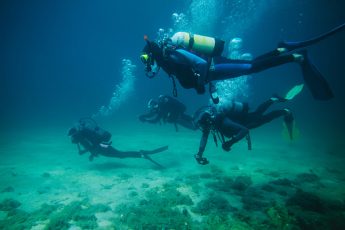Introduction
Quick Navigation
Your entire experience underwater is none other than the ability to maintain a level of buoyancy control. Divers or Swimmers exploring the underwater environment not only practice safety but also protect this space with excellent buoyancy. In most Diving Schools, this concept of buoyancy control is one of the most important things taught because survival depends on it.
What is Buoyancy, and What are the Factors Responsible?
Buoyancy means not being underweighted or overweighted (improper weighting); instead, it means maintaining a balance with the water body to dive and float properly.
Generally, six factors are responsible for buoyancy control, and they include:
BCD Inflation Level
Exposure Suit
Depth
Breath Control
Diver’s Trim
The Amount of Lead on a Diver
If these factors are considered, mastering buoyancy skills and learning how to control won’t be difficult.
How Do You Improve Buoyancy Control?
Inexperienced divers need to learn how to improve buoyancy control to have a fantastic time underwater. To do that, some basic tips might come in useful. They include:
Proper Weighting
The commonest factor that compromises your buoyancy underwater is improper weighting. It is quite common in beginners or new divers. Without the help of a diving instructor, it may be impossible to get yourself properly weighted for the experience.
However, a useful tip to ensure proper weighting by adding weights to new divers. Many instructors use this method to prevent accidents and allow these divers to perform new skills.
Beginner divers stay overweighted for as long as possible until they can finally master the art of carrying a minimum amount of weight for buoyancy control.
Understanding the Laws of Physics – Boyle’s Law
Another useful tip to improve buoyancy control underwater is understanding one of the laws of physics, i.e., Boyle’s Law. Many things could go right with just the knowledge of what this Law entails.
Boyle’s Law states that: “In the multiplying of the pressure surrounding a gas and the gas volume, the result will always be equal.” This Law, in layman terms, means: “the higher the pressure, the lower the volume, and vis-à-vis.”
In diving, water pressure increases while BCD, cylinder, lungs, and exposure suit decreases on descent and vice-versa. The understanding of this concept will help you know how to maintain better buoyancy underwater.
Do Buoyancy and Pre-Dive Weight Checks
A lifesaving tip for diving is practicing buoyancy and pre-dive weight checks before doing the real thing. It is a routine check that involves knowing the amount of weight you will need to carry underwater on a particular day. Here, you will need your diving gear and a fellow diver in a dive boat to help you through the entire process.
Two things might happen during your pre-dive weight check – either you float or sink. If you float, you will need to add more weights; on the other hand, if you sink, you have to drop a weight or two. The real test of buoyancy is having your head at eye level and the rest of your body underwater.
Find out how to complete a pre-dive weight check here.
Watch Body Positioning
The position of your body, as aforementioned, has a role to play in your buoyancy control. Therefore, it is important that you check all the diving accessories on you, i.e., the wetsuit, fins, scuba mask, etc. Your wetsuit might not make much of a difference, but your fins do.
The fins are the most important for trim, and a great tip for ensuring buoyancy is to make sure they are not aligned horizontally with the body. If they are, you might want to compensate for impromptu descent or ascent, affecting your balance and compromising neutral buoyancy.
Additionally, you should ensure not to keep much weight around the waist because the hips might find it difficult to move freely.
Get Familiar with Your Buoyancy Control Device (Buoyancy Compensator)
The most significant equipment you need when diving is a Buoyancy Control Device (BCD). You need this device at every point of pre-dive weight check to ensure that you are accurately weighted and ready to go diving. With a proper understanding of this piece of equipment, it is possible to prevent unnecessary diving accidents.
The first thing you are taught as a new diver is how to get familiar with BCDs. Here, you learn how to use an inflator hose to release air from the BCD in a different position – head-down. While you are using this piece of equipment, you should ensure it is the ideal weight to learn with – neither big nor small, but moderate.
Take Breath Control Exercise
It is no surprise that breathing is one consequential thing in diving, and it has a role to play in buoyancy control. Unfortunately, you are to take a breath control exercise, which may almost seem difficult. You are taught never to use the inflate button during ascension but your lungs, which ultimately means better buoyancy control.
Moreover, it would be best to learn how to use your lungs because breathing affects body position in the water column. Also, try to adjust buoyancy with the lungs before switching to a BCD.
Keep Your Hands Off
If you need to know now, your diving power comes from your legs, not your hands. So, if you think using your hands to control direction is the way to go, you should ignore that thought because it can affect your buoyancy. It also limits your dependability on your lungs and BCD to breathe properly underwater.
Conclusion
If there is anything you should take more seriously when it comes to diving, it is your buoyancy control. It is an active way to have a wonderful experience underwater and protect yourself from many accidents. With the tips mentioned above, you shouldn’t have a difficult time trying to maintain neutral buoyancy and explore open waters.

